Explore Kom Ombo Temple To Worship Deities And Experience Divinity

In a place where the Nile River helped old civilisations grow, the Kom Ombo Temple is a symbol of religious peace. It’s dedicated to the gods Sobek and Horus. This amazing building from the Ptolemaic period has two identical sanctuaries. They show how the crocodile god of fertility and the falcon-headed god who protected rulers could exist together. The big stone walls have detailed carvings on them, which make visitors want to learn more about Egyptian mythology. Walking through the famous courtyard and rooms of Kom Ombo gives a fascinating look into a time when people really respected their gods and did everything they could to keep them happy.
About Kom Ombo Temple
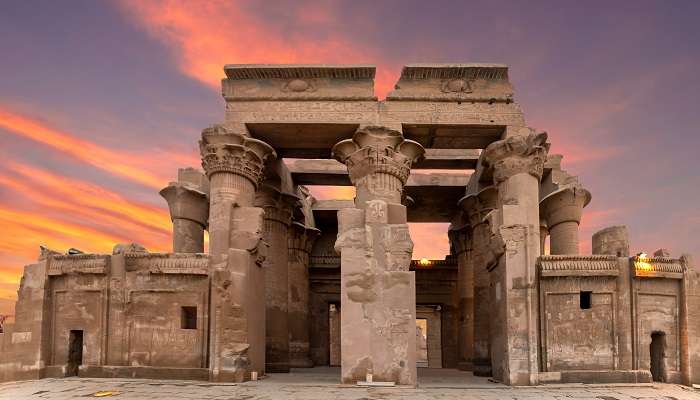
The Kom Ombo Temple, situated in the town of Kom Ombo in Upper Egypt, is a unique architectural marvel from the Ptolemaic dynasty. The Kom Ombo temple was built between 180 and 47 BC. It saw further additions during the Roman era. What sets this temple apart is its ‘double’ design. It houses two courts, halls, sanctuaries, and rooms dedicated to a different set of gods. The southern half worships the crocodile god Sobek, who is associated with fertility and the world’s creation, along with Hathor and Khonsu.
The northern half, on the other hand, is devoted to the falcon god Haroeris, also known as “Horus the Elder,” and his companions Tasenetnofret (the Good Sister) and Panebtawy (Lord of the Two Lands). The temple’s layout is perfectly symmetrical along its central axis. Despite the damages it suffered over the centuries due to earthquakes and other events, the temple remains a sight.
Must Read: Best Places To Visit In Egypt
Kom Ombo Temple History
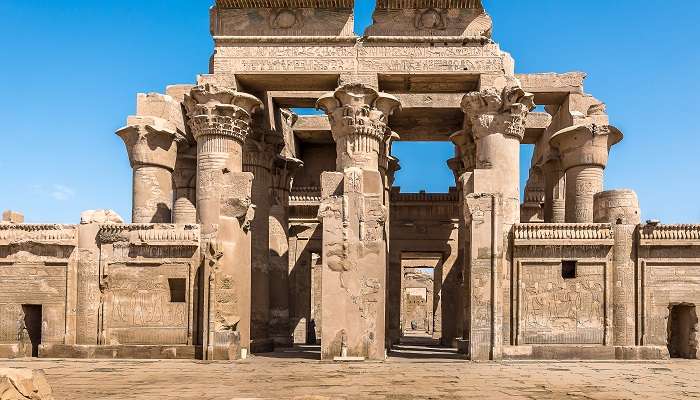
The Kom Ombo Temple in Egypt was built during the time of the Ptolemaic dynasty, from 305 BC to 30 BC. It was made for two gods: Sobek, the crocodile god, and Haroeris, the falcon god. The temple is special because it has two parts, each with its own entrance and sanctuary for one of the gods.
The building of the temple started when Ptolemy VI Philometor was in power (180-145 BC). It was made bigger by Ptolemy VIII Euergetes (145-116 BC) and finished when Ptolemy XII Auletes was ruling (80-51 BC). People used the Kom Ombo Temple for worship until it was left behind a long time ago.
Even though Kom Ombo is famous now for being built during the Greco-Roman time, people have lived in the area since before the Egyptian dynasties started. There are many old burial sites in and around the area. The town’s name, Kom Ombo, means “hill of gold”, which shows how important it was to the ancient Egyptians. But the town only really grew when the Ptolemies were in charge of Egypt.
The Ptolemies set up a lot of permanent military bases near the Red Sea. This helped trade between towns along the Nile and these bases. Kom Ombo became an important stop for many trading groups. The town’s most prosperous period was under Roman rule, during which it became the capital and administrative centre of the province. During this time, significant portions of the Temple of Kom Ombo were constructed, and many sections were restored and renovated.
Kom Ombo Temple Facts
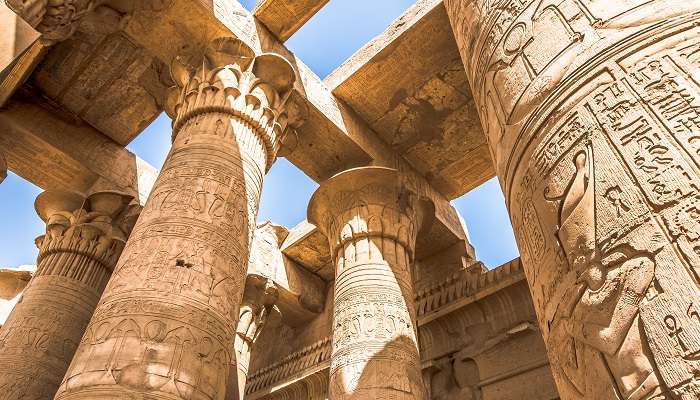
Some of the Kom Ombo Temple facts are as follows:
- Every year during Thoth, the first month of the Ancient Egyptian calendar, a festival is held at the temple to honour Sobek and Haroeris. During this festival, priests perform rituals, including offerings to the gods and animal sacrifices.
- The temple’s ‘double’ design is manifested in the duplication of courts, halls, sanctuaries, and rooms for both sets of gods.
- While a temple honouring these gods was present during the New Kingdom, the site’s significance amplified during the Ptolemaic Kingdom.
- The temple’s rear wall showcases a collection of surgical tools.
- The Crocodile Museum displays a selection of the three hundred crocodile mummies found nearby.
- The temple has suffered damage from the Nile, earthquakes, and later construction projects that repurposed its stones.
Suggested Read: Best Cities To Visit In Egypt
Kom Ombo Temple: Architecture And Design
The temple is mainly made of limestone and has a rectangular shape. It’s like other temples from the time of the Greeks and Romans, like the Dendara and Philae Temples. These are some of the most important sites in Upper Egypt and many tourists visit them every year. The layout of the Temple of Kom Ombo begins with a front courtyard, followed by a hypostyle hall, three inner halls, and two sanctuaries, one dedicated to Sobek and the other to Horus.
1. The First Pylon
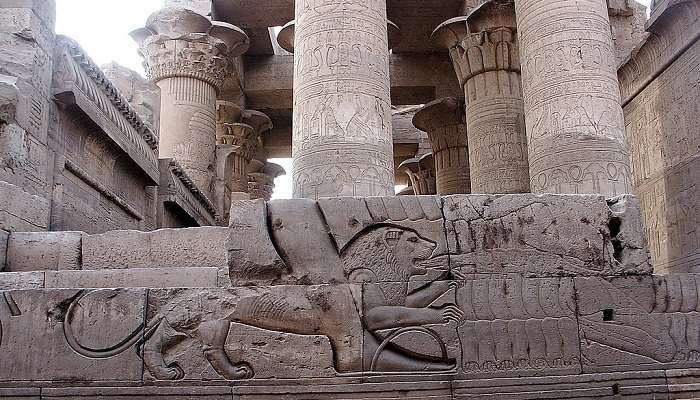
The first pylon of Kom Ombo originally featured two gateways, but only the lower parts of the central pillar and the right-wing remain today, with the left-hand half entirely gone. Upon entering, visitors can see (from left to right) the gods Sobek, Hathor, and Khons on the right-hand front wall, along with a 52-line hieroglyphic text and a relief of the Roman Emperor Domitian wearing the crowns of Upper Egypt.
2. The Forecourt

The forecourt of the temple, similar to that of Edfu’s Temple of Horus, was initially surrounded on three sides by colonnades, though only the lower halves of the 16 columns remain today. The reliefs, depicting Tiberius making offerings, are notable for their vibrant colouring. In the centre of the courtyard is a square altar base, with stone screens along the far side.
3. The Vestibule

The vestibule features 10 columns adorned with rich palm capitals, and both the walls and columns are embellished with reliefs. The ceiling over the main two aisles is decorated with paintings of flying vultures. The mural reliefs in the vestibule are especially fine, Among these is one to the left of the north entryway, which depicts Neos Dionysos receiving a blessing from a lion-headed Isis while standing alongside Haroeris.
4. Hypostyle Hall

Two doorways from the vestibule lead into the hypostyle hall, where the roof is supported by 10 papyrus columns with floral capitals. The column shafts depict Euergetes making offerings to various gods, while the wall reliefs show him conversing with the gods. The revered Ombos crocodile is located between the vestibule doors, while reliefs depicting Euergetes II’s older brother Philometor presenting something to the falcon-headed Haroeris are located between the doors leading into the temple’s back.
The falcon-headed Haroeris is seen in a prominent relief on the left (northern) wall. It offers the pharaoh of the Ptolemaic era the curved sword of triumph and the hieroglyph signifying perpetual life. Behind the pharaoh stands his sister Cleopatra VII and his wife Cleopatra.
5. Antechambers
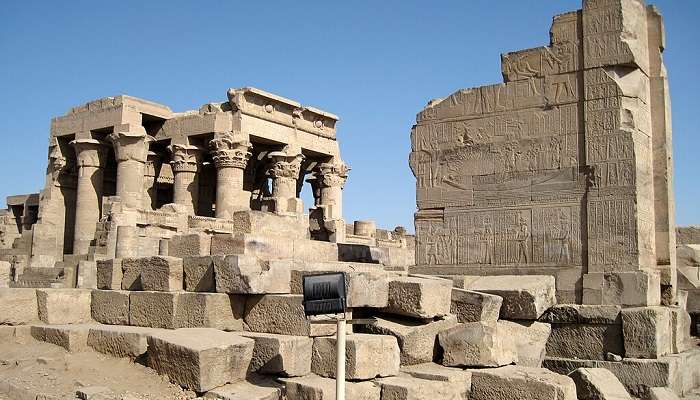
Three antechambers lead from the hypostyle hall into the inner temple area, with each antechamber slightly higher than the one before. The walls are covered with fine reliefs. Small rooms on the left-hand side of the antechambers likely served as temple store rooms.
A relief depicting Philometor wearing a long white cloak and Cleopatra standing in front of the pharaoh’s name is written on a palm branch by the falcon-headed moon deity Khons. bearing the sign for a long reign is located on the back wall of the third antechamber, between the two doorways. The three main gods of Ombos, Haroeris, and Sobek are behind them.
Entering through the two doors in the rear wall of the third antechamber leads to the temple’s sanctuary area, divided to worship Haroeris (left) and Sobek (right). Each sanctuary contains a black granite base for the sacred barque, which would have held the god’s image. Surrounding the chapels are several smaller rooms with crypts.
6. Inner Passageway
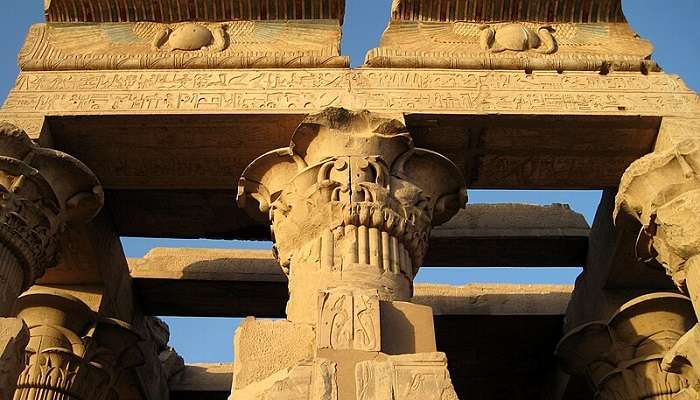
Visitors Guests can enter the interior corridor of the temple by going back to the entryway. At the far end, seven little chambers with incomplete reliefs representing various phases of the artist’s process and a few partially written but unfinished sketches may be found.
Kom Ombo Temple Opening Hours, Entrance Fees and Best Time to Visit
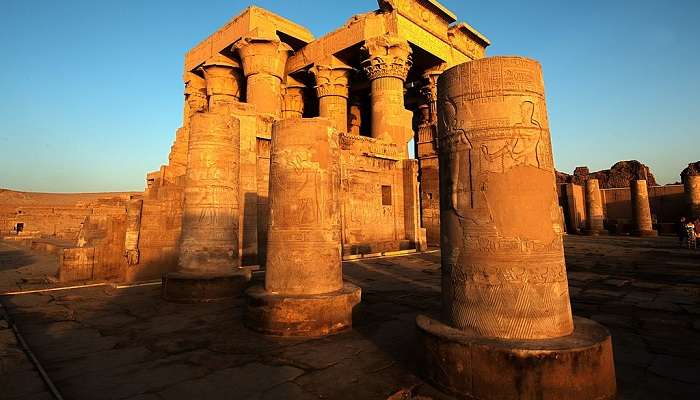
The Kom Ombo Temple is open from 6:00 am to 9:00 pm throughout the summer (May to September), with the final ticket being sold at 8:00 pm. The temple is open from 6:30 am to 5:00 pm throughout the winter (October to April), with the final ticket being sold at 4:00 pm. Entry costs are 80 EGP for adults and 40 EGP for students. However, these fees don’t cover guided tours, which are advisable for a deeper understanding of the temple’s history.
The best time to visit the Kom Ombo Temple is typically in the cooler winter months, which span from December to February. During this season, the weather is pleasantly cool and dry, offering an ideal climate for exploring the historic site. Additionally, the tourist traffic is lower, providing a more serene and intimate experience of the temple’s wonders.
Suggested Read: Facts About The Great Pyramids Of Giza
How To Reach Kom Ombo Temple
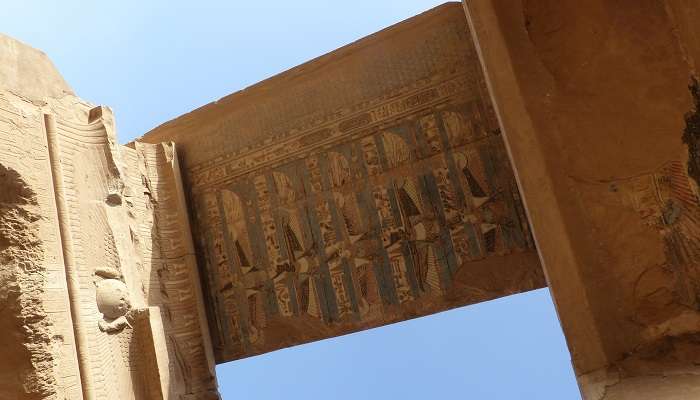
To reach the Kom Ombo Temple, located in the Aswan Governorate of Upper Egypt, you have several options:
By Train
Kom Ombo has its own station on the line that runs through the entire Nile Valley, from Cairo to Aswan. The overnight train is the most recommended option for tourists, offering a comfortable journey. Day trains are also available, mainly used by Egyptians.
By Road
If you’re coming from Aswan, it takes approximately 1 hour and 3 minutes (46.5 km) via the 02/Cairo – Aswan Eastern Desert Road/Edfo – Aswan/Nagaa Hammadi – Aswan/Route 75M. Taxis are readily available from Aswan and Luxor.
By Nile Cruise
Many Nile cruises stop at Kom Ombo, as it’s a popular destination along the route. You can also reach Kom Ombo by a private sailing boat or a larger motorboat.
Further Read: 4000 Year Old Tomb In Egypt
Kom Ombo Temple is a remarkable ancient Egyptian monument that stands as a testament to the ingenuity and architectural prowess of the Pharaohs. Its intricate carvings and hieroglyphics offer a glimpse into Egypt’s rich cultural heritage, leaving visitors in awe of the country’s storied past. If you’re yearning for an unforgettable journey through time, book your trip to Egypt today. Take in the breathtaking majesty of the Nile Valley, where ancient marvels are waiting to awe and inspire you. Seize the chance to discover the enduring charm of this magical place.
For our editorial codes of conduct and copyright disclaimer, please click here.
Cover Image Source: Shutterstock
Frequently Asked Questions About Kom Ombo Temple
What is Kom Ombo famous for?
The Kom Ombo is famous for its unique double temple dedicated to two sets of gods. It was constructed during the Ptolemaic dynasty and is known for its architectural beauty and historical significance.
Who are the gods of Kom Ombo?
The temple is dedicated to two gods namely the Sobek, the crocodile god of fertility, along with Hathor and Khonsu, and the northern part to Haroeris (Horus the Elder), along with Tasenetnofret and Panebtawy.
How old is Kom Ombo Temple?
The Kom Ombo Temple was constructed during the Ptolemaic dynasty, between 180–47 BC, making it over 2,000 years old.
How far is Kom Ombo from Aswan?
Kom Ombo is approximately 47.6 Km from Aswan, and under normal traffic conditions, it takes about 40 minutes to travel by car.
Who built the Kom Ombo Temple?
The temple was initiated by Ptolemy VI Philometor around 180 BC and added to by subsequent Ptolemaic rulers, most notably Ptolemy XIII Theos Philopator.
People Also Read:
Bhuleshwar Temple Bhojeshwar Temple Wat Phra That Doi Suthep

With a passion for exploring and travelling to the roads long forgotten, experience the world through enthralling stories and adventures. Join me as I share my experiences at some of the world’s most popular tourist destinations and quench that pestering curiosity with something exciting!











